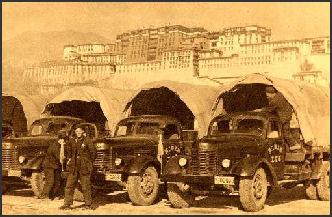
ChineseTrucks under Potala PalaceOn October 7, 1950, some 40,000 battled-hardened Chinese P.L.A. troops crossed the upper Yangzte River into eastern Tibet. A poorly-armed force of 4,000 Tibetans was quickly overrun. A Tibetan who recalled hearing about the advance on the radio, later told the Independent, "The announcement was not a complete shock: we had heard reports that the poor people of China had risen up in revolution, and all the rumors that these Communists would come to Tibet. But still there was panic."
Tibet may have been poor and isolated when the People's Liberation Army began its invasion in 1950, but it was also a land whose people considered themselves essentially independent.At the time Communist forces marched into Tibet, the former empire was ill- prepared to defend itself. It had a poorly trained army, no paved roads, and no more than a few speakers of any Western language. Had the country modernized earlier instead of shunning reforms, the Dalai Lama later wrote, "I am quite certain that Tibet's situation today would be very different." [Source: Evan Osnos, The New Yorker]
As the P.L.A, advanced on the eastern Tibetan town of Chamdo. Buddhist monks prayed hard but there efforts didn't help. The Chinese easily took Chamdo and captured more than half of Tibet's 10,000-man army. In response to crisis, the Tibetan government enthroned the 15-year-old, 14th Dalai Lama. There was jubilation and dancing in streets but all this, and appeals by the United Nations, had little effect on the Chinese advance.
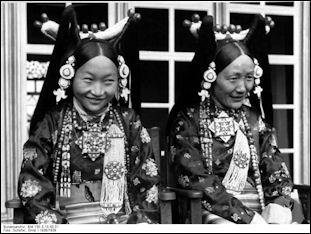
Tibet in 1938 before
the Chinese took it overChinese forces, carrying portraits of Mao Zedong, peacefully entered Lhasa in 1950 to "liberate" the city. Chinese call the event the “peaceful liberation." Beijing enacted the 17-point Agreement on Measures for the Peaceful Liberation of Tibet with a forged seal of the Dalai Lama in March, 1951. In this document Beijing vowed not to change the Tibetan social system and promised.a Hong Kong-like two-system structure, self government and freedom of religion but provided no mechanisms for guaranteeing the agreement's terms. Later, Beijing reneged on most of the promises it made.
In 1951, when Gen. Zhang Jinwu was sent to Lhasa as the first representative of Communist China in Tibet, he reportedly asked Mao Zedong if he should kotow to the Dalai Lama as representatives of the Chinese Emperor had done in the past. Mao is said to have replied: “For the sake of the whole Tibetan people, why not?”
Websites and Resources
Good Websites and Sources: Tibetan History Timeline haiweitrails.com ; Friends of Tibet friends-of-tibet.org ; Wikipedia articleWikipedia ; History of Nations site historyofnations.net ; Chinese Government site on Tibetan History xinhuanet.com ; Tibet Under China: Tibet China Conflict PDF file eastwestcenter.org ; Tibet and China, Two Distinct Views rangzen.org/history ; Chinese Government's Take on Tibetan History index-china.com; Links in this Website: TIBETAN HISTORY Factsanddetails.com/China ; TIBET UNDER CHINA Factsanddetails.com/China ;TIBETAN UPRISING IN 2008 Factsanddetails.com/China ; FALL OUT OF TIBETAN UPRISING IN 2008 Factsanddetails.com/China
Book: Tibetan Civilization by Rolf Alfred Stein. Robert Thurman, a friend of the Dalai Lama and professor of Indo-Tibetan studies at Columbia University, is regarded the preeminent scholar on Tibet in the United States. The Dragon in the Land of Snows by Tsering Shakya (Random House, 1998) is a first rate book on the history of Tibet under Chinese occupation. History of Modern Tibet by Melvyn Goldstein is a two-volume set that documents the events during the first half of the twentieth century that culminated in the arrival of the PLA in Lhasa in 1951 and the incorporation of Tibet into the People's Republic of China. The second volume of that history leaves off in 1955, just as Mao launches the Socialist Transformation Campaign throughout China and before the Khamba uprising in Sichuan Province against the implementation of socialist reforms spills over into Tibet.

Tibet in 1938 before
the Chinese took it overGood Websites and Sources on Tibet: Central Tibetan Administration (Tibetan government in Exile) www.tibet.com ; Chinese Government Tibet website eng.tibet.cn/ Wikipedia Wikipedia Tibetan Resources <a href="http://www.columbia.edu/cu/lweb/indiv/eastasian/Tibetan/links.html;%20Tibetan%20News%20site%20%3Ca%20href=" http:="" www.phayul.com="" "="" target="_blank" style="box-sizing: border-box; color: rgb(53, 111, 139);">phayul.com ; Open Directory dmoz.org/Regional/Asia/China/Tibet/ ; Snow Lion Publications (books on Tibet) snowlionpub.com ; Photos Tibet Photo Gallery Tibet Gallery Terra Nomada Terra Nomada ; Tibetan Cultural Sites: Conservancy for Tibetan Art and Culture tibetanculture.org ; Tibet Trip tibettrip.com ; Tibetan Cultural Region Directory kotan.org ;
Chinese Government Sources on Tibet: China Tibet Information Centeren.tibet.cn ; White Paper on Tibetan Culture english.people.com.cn ; Tibet Activist Groups: Tibet Online tibet.org ; Students for a Free Tibet studentsforafreetibet.org ; Students for a Free Tibet UK /sftuk.org ; Friends of Tibet friendsoftibet.org ; Tibetan Review tibetan.review.to ; Campaign for Tibet (Save Tibet) savetibet.org ; Tibet Society tibetsociety.com ; Free Tibetfreetibet.org ; Tibetan Centre for Human Rights and Democracy tchrd.org
Tibetan Studies and Tibet Research: Tibetan Resources on The Web (Columbia University C.V. Starr East Asian Library ) columbia.edu ; Tibetan and Himalayan Libray thlib.org Digital Himalaya ; digitalhimalaya.com ; Tibetan Studies Maps WWW Virtual Library ciolek.com/WWWVL-TibetanStudies ; Center for Research of Tibet case.edu ; Center for Advanced Tibetan Studies amnyemachen.org ; Tibetan Studies resources blog tibetan-studies-resources.blogspot.com ; News, Electronic Journals ciolek.com/WWWVLPages ; Websites and Sources on Ethnic Groups in China with a Tibet section (click Tibetans or the ethnic group you want) : Ethnic China (very good site with good academic articles) ethnic-china.com ; Cultural China (site with nice photos cultural-china.com ; China Travel chinatravel.com ; Wikipedia List of Ethnic Minorities in China Wikipedia ; Travel China Guide travelchinaguide.com ; China.org (government source) china.org.cn ; OMF international (a Christian group) omf.org ; People's Daily (government source) peopledaily.com.cn ; Ethnic Publishing House (government source)e56.com.cn ; Paul Noll site` paulnoll.com ; China Highlights (on some groups) China Highlights
Tibet Before the Chinese Arrival in 1950
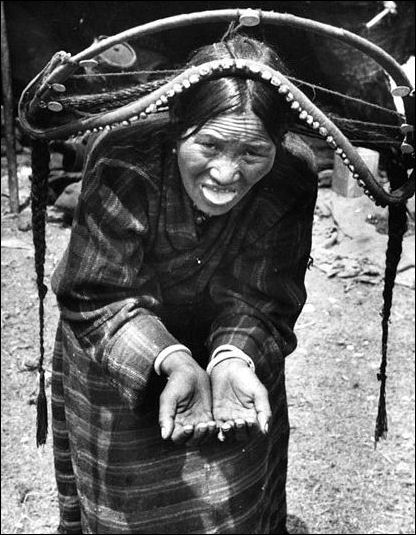
Tibet in 1938 before
the Chinese took it overIndependent Tibet was no Shangri-La. It very isolated and poor. Before the Chinese arrived, life expectancy was 36 years, the literacy rate was five percent and 95 percent of the population were hereditary serfs and slaves. Corruption and crime were endemic. Bandits roamed the countryside; lamas and noblemen enriched themselves on the backs of poor peasants. Potala palace was described as "a real robbery shop...an eggshell intact on the outside but rotten within."
There were no motored vehicles, no schools (although monasteries provided a form a schooling), no banks and no money in Tibet. Barley, salt, tea, furs, cloth and yak butter were used as a means of exchange. Up until the 1960s most Tibetans did not have matches, gunpowder or wheels (other than those used for praying). Fires were lit with a flint and tinder.
The monastic elite lived off the labor and taxes of peasants. Aristocrats in silk robes, jewelry and brocade lived next to serfs in rags. The ruling class was not afraid to use violence to hold back reforms and maintain the status quo. Criminals had their hands and arms lopped off and were blinded as punishments. Some had their eyes gouged out while a bread-size stone was placed on their head. Others had yak knucklebones pressed on both temples until their eyeballs popped out. Such punishments were outlawed by the predecessor the current Dalai Lama in 1913.
One old Tibetan man told the Times of London, “I remember my father and mother never had enough to eat; they never had enough warm clothes. By day they were humans, by night they were like dogs...no proper home, food of clothes."
Some argue the system was not as harsh as the Chinese have made it out to be. Robert Barnett, director of modern Tibetan studies at Columbia University told the Times of London, “The Chinese trick is to say the words “serf”and “feudal”and make us think brutal."
In the 1930s a feud broke out between the Dalai Lama and the Panchen Lama. In 1933, the 13th Dalai Lama died and the country fell under the leadership of the regent of Reting. In 1947, an attempted coup, known as the Reting Conspiracy, shook Lhasa. In 1949, the Communists took over China. Many Chinese felt that had a moral obligation to liberate Tibetans from a bad system and help Tibet modernize.
Many Tibetans, especially educated ones in the larger towns, welcomed the Chinese and were eager to modernize Tibet. They embraced the Communists as means of advancing a feudal society ruled by elite monks and landlords.
Chinese Take on Tibetan History

Evan Osnos wrote in The New Yorker: “Both sides agreed that China's Mongol rulers had amassed great authority in Tibet by the thirteenth century. But Tibetans say the bond was based principally on a shared religion, and they argue that the Mongols did not represent the Chinese. Historians in China consider the Mongol era the beginning of seven hundred years of political sovereignty over Tibet." [Source: Evan Osnos, The New Yorker, October 4, 2010]
Historically, Osnos wrote “the vast majority of Han are proud of their role in Tibet, which they see as a long, costly process of extending civilization to a backward region. The Han in the lowlands had little in common with the pastoral people in the mountains---no shared language or diet---and Chinese historians explained that a Tang-dynasty princess taught Tibetans about agriculture, silk, paper, modern medicine, and industry, and stopped them from painting their faces red." [Ibid]
“In the twentieth century, when China secured Tibet, Inner Mongolia, and Xinjiang within its borders, the move was hailed by the Chinese people as the end of a century of foreign invasion and humiliation. The Dalai Lama, from that perspective, stood in the path of history, and when he went into exile Chinese newsreels recorded images of farmers denouncing their former landlords and destroying records of hereditary debts." [Ibid]
“Anyone over fifty years old in China today has grown up with those scenes dramatized in influential films like ‘serf," a 1963 drama about a freed Tibetan servant and his grateful encounter with the People's Liberation Army. Han Chinese who are only a generation or two removed from poverty are inclined to view China's investment as a sacrifice." A Chinese graduate student at Yale told the The New Yorker, “My father is an educated man. He has worked all over Tibet for years and, to this day, he can't really respect Tibetans. He doesn't see any intellectual output from them."
Events Leading Up to the Chinese Occupation of Tibet
Immediately after the communist party took power in China in 1949 it began asserting its claim that Tibet was part of Chinese territory and its people were crying out for "liberation" from "imperialist forces" and from the "reactionary feudal regime in Lhasa". [Source: Tibet Oline tibet.org*~*]
By October 1950 the People's Liberation Army had penetrated Tibet as far as Chamdo the capital of Kham province and headquarters of the Tibetan Army's Eastern Command. The region was routed and the Governor, Ngawang Jigme Ngabo, taken prisoner. Chinese forces were also stealthily infiltrating Tibet's north-eastern border Province, Amdo, but avoiding military clashes which would alert international interest. *~*
In 1950, the 15-year-old Dalai Lama, his entourage and select government officials, evacuated the capital and set up a provisional administration near the Indian border at Yatung. In July 1951 they were persuaded by Chinese Officials to return to Lhasa. *~*
On September 9, 1951, a vanguard of 3,000 Chinese "liberation forces" marched into the capital. China claims it "peacefully liberated" Tibet in 1950, saying it ended serfdom and brought development to a backward, poverty-stricken region. China's leadership claimed it had to come to “liberate” Tibet from “Imperialism” even there was no Americans and only about a handful of Britains in Tibet at the time. [Source: buddhism-controversy-blog.com, April 21, 2013]
Dalai Lama and the Invasion of Tibet

Tibet in 1938The Dalai Lama was 16 when the Chinese entered Lhasa in 1950. He responded to the crisis by taking over his duties as the temporal leader of Tibet, two years before he was officially supposed to do so. "I had to put my boyhood behind me," he said, "and immediately prepare myself to lead my country, as well as I could, against the vast power of Communist China."
The Dalai Lama wrote in Time, "I was very young when I first heard the word communist...Some monks who were helping me with my studies...had talked about the destruction that had taken place since the Communists came to Mongolia. We did not known anything about Marxist ideology. But we all feared destruction and thought of Communists with terror."
As a young man the Dalai Lama was deeply interested in Marxism. He was impressed by Chinese reforms and wrote poems praising Mao Zedong. "It was only when I went to China in 1954-55 that I actually studied Marxist ideology and learned about the Chinese Revolution. Once I understood Marxism, my attitude changed completely. I was so attached to Marxism, I even expressed my wish to become a Communist party member."
"Tibet at that time was very, very backward," teh Dalai Lama said. "The ruling class did not seem to care, and there was much inequality. Marxism talked about an equal and just distribution of wealth. I was very much in favor of this." His view changed when “the Chinese Communists brought to Tibet a so-called liberation." “Chinese Communists carried out aggression and suppression in Tibet. Whenever there was opposition, it was simply crushed. They started destroying monasteries and killing and arresting lamas."
"In the beginning, I had hoped that we could find a peaceful solution. I even went to China to meet Chairman Mao. We had several meetings in 1955...Until the summer of 1956, the Chinese had some level of trust in me." That changed after the Dalai Lama made a visit to India with Beijing approval and visited Tibetan freedom fighters there.
International Response to the Invasion of Tibet
At the time the Chinese entered Tibet, the attention of the world was focused on the Korean peninsula, where the North Koreans had just invaded South Korea.
Tibet was perceived in the West as mythical kingdom like Shangri-la and little was known about it. Tibet and its appeals to the U.N. for help after the invasion were largely ignored. Vetoes by the Soviet Union blocked any United Nations intervention.
Not helping matters wee the facts that Tibet never joined the League of Nations or the United Nations. "It never occurred to us that our independence...needed any legal proof to the outside world," the Dalai Lama wrote in his autobiography.
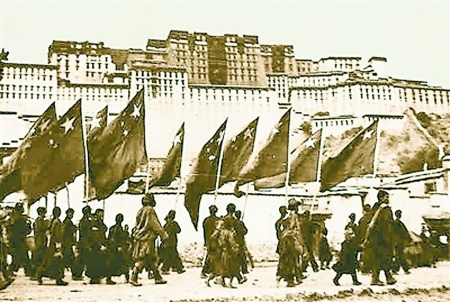
PLA marching Lhasa
Events After the Chinese Occupation of Tibet in 1951
A 1951 treaty spelling out how power would be shared between Beijing and Lhasa swiftly unraveled amid violations and recriminations. By 1954, 222,000 members of the People's Liberation Army (PLA) were stationed in Tibet and famine conditions became rampant as the country's delicate subsistence agricultural system was stretched beyond its capacity. [Source: Tibet Oline tibet.org *~*]
In April 1956, the Chinese inaugurated the Preparatory Committee for the Autonomous Region of Tibet (PCART) in Lhasa, headed by the Dalai Lama and ostensibly convened to modernize the country. In effect, it was a rubber stamp committee set up to validate Chinese claims. *~*
In the later fifties, Lhasa became increasingly politicized and a non-violent resistance evolved, organized by Mimang Tsongdu, a popular and spontaneous citizens' group. Posters denouncing the occupation went up. Stones and dried yak dung were hurled at Chinese street parades. During that period, when the directive from Beijing was still to woo Tibetans rather than oppress them, only the more extreme Mimang Tsongdu leaders and orators faced arrest.
In February 1956, revolt broke out in several areas in Eastern Tibet and heavy casualties were inflicted on the Chinese occupation army by local Kham and Amdo guerilla forces. Chinese troops were relocated from Western to Eastern Tibet to strengthen their forces to 100,000 and "clear up the rebels." Attempts to disarm the Khampas provoked such violent resistance that the Chinese decided to take more militant measures. The PLA then began bombing and pillaging monasteries in Eastern Tibet, arresting nobles, senior monks and guerrilla leaders and publicly torturing and executing them to discourage the large-scale and punitive resistance they were facing. *~*
In Lhasa, 30,000 PLA troops maintained a wary eye as refugees from the fighting in distant Kham and Amdo swelled the population by around 10,000 and formed camps on the city's perimeter. By December 1958, a revolt was simmering and the Chinese military command was threatening to bomb Lhasa and the Dalai Lama's palace if the unrest was not contained. To Lhasa's south and north-east 20,000 guerrillas and several thousand civilians had been engaging with Chinese troops. *~*
Tibet Under Liberal Chinese Rule in the 1950s
Throughout most of the 1950s, most Tibetans still had control over their own affairs and the Dalai Lama continued to live in Lhasa. The Chinese presence was generally benign and positive. They built roads, schools and hospitals and let the Tibetans practice their religion and customs.
Tibetans admired the Chinese for their honesty and efficiency but were taken aback by many Chinese customs and habits. They were appalled by the way Chinese put worms on hooks and fished and used "night soil" (human feces) as fertilizer for vegetables.
Recalling how life improved under the Communists, one old Tibetan man told the Times of London, he was able to try rich yak butter tea for the first time. “It was not great, but it was better [than what he had before]. We could eat rice and noodles and salty butter tea, which we did not have before."
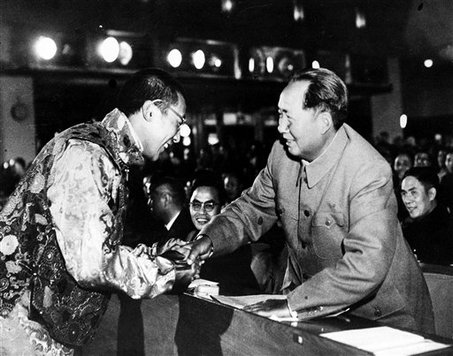
Mao and the Dalai Lama in 1954
A new kind of feudal system was created, with taxes given to Chinese government instead of the lamas. The Chinese presence caused food shortages and an increased cost of living. Demonstrations and disturbances occurred from time to time. Reports of massacres and political indoctrination came out of Kham.
But some had predicted bad things were ging to happen In 1932, the Thirteenth Dalai Lama wrote in his will that Tibet as Tibetans had known it was about to be destroyed by “barbaric red Communists." “Our spiritual and cultural traditions will be completely eradicated. Even the names of the Dalai and Panchen Lamas will be erased...The monasteries will be looted and destroyed, and the monks and nuns will be killed or chased away...We will become like slaves to our conquerors...and the days and nights will pass slowly with great suffering and terror."
Chinese Take Over Tibet
The Chinese slowly undermined Tibetan authority. The Tibetan areas of Kham and Amdo were annexed and added to the Chinese provinces of Sichuan and Qinghai. Monasteries were looted and land was confiscated from the Tibetan aristocracy.
Many educated Tibetans actually welcomed the Chinese communists in 1950. The Buddhist clergy was seen, not without reason, as hidebound and oppressive. Chinese communism promised modernization.
A propaganda campaign was launched. One Tibetan told the Independent, "A loudspeaker was set up in the heart of Lhasa, broadcasting propaganda in Tibetan. I kept asking myself what all these new ideas were, these -isms; socialism, communism, capitalism and imperialism. We had never heard of them before."
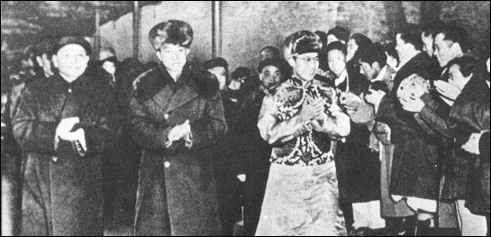
Deng Xiaoping and the Dalai Lama in 1954
Things began deteriorate after Mao remarked during a 1954 meeting with the Dalai Lama that "religion is poison" and Beijing voiced its determination in freeing Tibetan serfs by breaking the lock on power by the Tibetan monasteries and aristocracy.
After that the pace of monastery destruction increased, hundreds of thousands of monks and nuns were driven from the monasteries. The Communists deliberately killed many senior monks regarded as the most powerful people in Tibet. The process continued through the Cultural Revolution.
In the years following 1950, when the Chinese asserted sovereignty over Tibet but accorded it a certain amount of autonomy, Tibetans found the soldiers of the People's Liberation Army to be polite and friendly. Gonchoe, a 74-year-old veteran of the Tibetan resistance movement told Belgian author Birgit van de Wijer: "The first time the Chinese people came into my country, they were helping people and brought whatever we needed." [Source: Dinah Gardner, South China Morning Post, January 30 2011]
In exile, the Dalai Lama looked for allies, but no nations recognized Tibet's claim to independence. Some of the Dalai Lama's brothers pursued another strategy: the C.I.A. was eager to cause problems for the new Chinese government,
However, by the mid-50s, China had begun to force its agrarian reforms onto people in the east of the country. "They killed high lamas and were against religion, and they caught people who didn't want to be communists," Gonchoe says.
Many Tibetans, possibly more than a million, starved to death during Chairman Mao's Great Leap Forward campaign.
Chinese View of the Chinese Occupation of the 1950s
According to to Chinese government: “With the founding of the People's Republic of China on October 1, 1949, the Tibetan areas in the western part of the country was liberated one after another and the Tibetans there entered a new period of historical development. In 1951, representatives of the Central People's Government and the Tibet local government held negotiations in Beijing and signed on May 23 a 17-article agreement on the peaceful liberation of Tibet. Soon afterwards, the central government representative Zhang Jingwu arrived in Lhasa and Chinese People's Liberation Army units marched into Tibet from Xinjiang, Qinghai, Sichuan and Yunnan in accordance with the agreement."Source: China.org china.org *|*]
“China's First National People's Congress was held in Beijing in 1954. The Dalai Lama, Bainqen Erdini and representatives of the Tibetan people attended the congress and later visited various places in the country. The State Council then called a meeting at which representatives of the Tibet local government, the Bainqen Kampo Lija and the Qamdo People's Liberation Committee formed a preparatory group for the establishment of the Tibet Autonomous Region after repeated consultations and discussions. In April 1956, a preparatory committee for the purpose was officially set up. *|*

Mao in Ramoche Monestary“Regional autonomy and social reforms were introduced cautiously and steadily in one Tibetan area after another according to their specific circumstances arising from the lopsided development in these areas due to historical reasons. A number of autonomous administrations have been established in Tibetan areas since the 1950s. They include the Tibet Autonomous Region, the Yushu, Hainan, Huangnan, Haibei and Golog Tibetan autonomous prefectures and the Haixi Mongolian, Tibetan and Kazak Autonomous Prefecture in Qinghai Province; the Gannan Tibet Autonomous Prefecture and the Tianzhu Tibetan Autonomous County in Gansu Province; the Garze and Aba Tibetan autonomous prefectures and the Muli Tibetan Autonomous County in Sichuan Province; and the Diqing Tibetan Autonomous Prefecture in Yunnan Province. *|*
“In light of the historical and social development of the Tibetan people, the central government introduced democratic reforms in various places according to local conditions and through patient explanation and persuasion. Experiments were first carried out to gain experience. A campaign against local despots and for the reduction of rent and interest was unfolded in the Tibetan areas of Northwest China in 1951 and 1952. In farming areas, people were mobilized to abolish rent in labor service and extra-economic coercion in the struggle to eliminate bandits and enemy agents. Sublet of land was banned. But rent for land owned by the monasteries was either intact or reduced or remitted after consultation. In pastoral areas, aid was given to herdsmen to develop production and experience was accumulated for democratic reforms and socialist transformation there. *|*
“In the Tibetan areas of Southwest China, peaceful reforms were introduced between 1955 and 1957 in the farming areas. Feudal land ownership and all feudal privileges were abolished after consultation between the laboring people and members of the upper strata. Usury was also abolished and slaves were freed and given jobs. The arms and weapons of manorial lords were confiscated. The government bought out the surplus houses, farm implements, livestock and grain of the landlords and serf owners. *|*
“It was clearly laid down in the agreement on the peaceful liberation of Tibet that democratic reforms would be carried out to satisfy the common desire of the peasants, herdsmen and slaves. But, in light of the special circumstances in Tibet, the central government declared that democratic reforms would not be introduced before 1962. However, the reactionary manorial lords, including monks and aristocrats, tried in every way to oppose the reforms." *|*
Events Leading up to March 10, 1959 Tibetan Revolt
In 1956, an uprising broke out in the Kham region of eastern Tibet. In March 1957, the Dalai Lama returned to Lhasa from India. In 1957 and 1958, armed rebellion spread to central Tibet and major protests were held in Lhasa.
On March 1, 1959, while the Dalai Lama was preoccupied with taking his Final Master of Metaphysics examination, two junior Chinese army officers visited him at the sacred Jokhang cathedral and pressed him to confirm a date on which he could attend a theatrical performance and tea at the Chinese Army Headquarters in Lhasa. The Dalai Lama replied that he would fix a date once the ceremonies had been completed This was an extraordinary occurrence for two reasons: one, the invitation was not conveyed through the Kashag (the Cabinet) as it should have been; and two, the party was not at the palace where such functions would normally have been held, but at the military headquarters - and the Dalai Lama had been asked to attend alone. [Source: Tibet Oline tibet.org*~*]
On March 7, 1959, the interpreter of General Tan Kuan-sen - one of the three military leaders in Lhasa rang the Chief Official Abbot demanding the date the Dalai Lama would attend their army camp. March 10 was confirmed. On March 8, 1959— Women's Day in China— the Patriotic Women's Association was treated to a harangue by General Tan Kuan-sen in which he threatened to shell and destroy monasteries if the Khampa guerrillas refused to surrender. Rinchen Dolma (Mary) Taring wrote in her autobiography, Daughter of Tibet”: “We knew that the ordinary people of Lhasa were being driven to open rebellion against the Chinese though they would have to fight machine-gunners with their bare hands." *~*
At 8:00am on March 9, 1959, two Chinese officers visited the commander of the Dalai Lama bodyguards' house and asked him to accompany them to see Brigadier Fu at the Chinese military headquarters in Lhasa. Brigadier Fu told him that on the following day there was to be no customary ceremony as the Dalai Lama moved from the Norbulinka summer palace to the army headquarters, two miles beyond. No armed bodyguard was to escort him and no Tibetan soldiers would be allowed beyond the Stone Bridge - a landmark on the perimeter of the sprawling army camp. By custom, an escort of twenty-five armed guards always accompanied the Dalai Lama and the entire city of Lhasa would line up whenever he went. Brigadier Fu told the commander of the Dalai Lama's bodyguards that under no circumstances should the Tibetan army cross the Stone bridge and the entire procedure must be kept strictly secret. The Chinese camp had always been an eyesore for the Tibetans and the fact that the Dalai Lama was now to visit it would surely create greater anxiety amongst the Tibetans. *~*
Tibetan Revolt in 1959
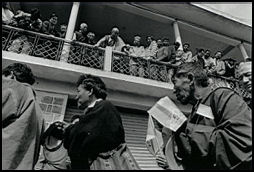
Dalai Lama greets protestorsOn Tibetan New Year in 1959 a major revolt occurred. To this day no one is sure how or why it began and how widespread it was. By most accounts, it started after the Dalai Lama was forced by the Chinese government to attend a performance of a Chinese folk dance troupe during the holiday festivities. Rumors began spreading that the Tibetan leader was going to attend without his usual phalanx of 25 bodyguards and that the Chinese planned to kidnap him. Large crowds that had assembled anyway for the holidays gathered around Norbulingka, the Dalai Lama's summer palace, and vowed to protect the Tibetan leader with their lives. The Dalai Lama had no choice but to cancel his appearance. The Chinese responded by declaring the 17-point agreement invalid. In an effort to head off violence, the Dalai Lama offered to turn himself over to the Chinese. The Chinese responded by firing two mortar shells into Norbulingka,"
March 10, 1959, the invitation for the Dalai Lama to visit the Chinese military camp provoked 30,000 loyal Tibetans to surround the Norbulinka palace, forming an human sea of protection for their Yeshe Norbu (nickname for the Dalai Lama, meaning "Precious Jewel"). They feared he would be abducted to Beijing to attend the upcoming Chinese National Assembly. This mobilization forced the Dalai Lama to turn down the army leader's invitation. Instead he was held a prisoner of devotion. [Source: Tibet Oline tibet.org*~*]
On March 12, about 5,000 Tibetan women marched through the streets of Lhasa carrying banners demanding "Tibet for Tibetans" and shouting "From today Tibet is Independent". They presented an appeal for help to the Indian Consulate-General in Lhasa. Mimang Tsongdu members and their supporters had erected barricades in Lhasa's narrow streets while the Chinese militia had positioned sandbag fortifications for machine guns on the city's flat rooftops. 3000 Tibetans in Lhasa signed their willingness to join the rebels manning the valley's ring of mountains. *~*
On March 15, around 3000 of the Dalai Lama's bodyguards left Lhasa to position themselves along an anticipated escape route. Khampa rebel leaders moved their most trusted men to strategic points. Stalwarts of the Tibetan Army merged with civilians to cover the chosen route. By this time the Tibetans were out-numbered 25 to 2. An estimated 30,000 to 50,000 Chinese troops wielded modern weapons and had 17 heavy guns surrounding the city. While the Chinese manned swiveling howitzers, the Tibetans were wielding cannons into position with mules. On March 16, Chinese heavy artillery was seen being moved to sites within range of Lhasa and particularly the Norbulinka. Rumours were rife of more troops being flown in from China. By nightfall Lhasa was certain that the Dalai Lama's palace was about to be shelled. *~*
At 4:00pm on March 17, 1959, the Chinese fired two mortar shells at the Norbulinka. They landed short of the palace walls in a marsh. This event triggered the Dalai Lama to finally decide to leave his homeland.
On March 19, fighting broke out in Lhasa late that night and raged for two days of hand-to-hand combat with odds stacked hopelessly against the Tibetan resistance. At 2.00 am the Chinese started shelling NorbuLingka. The Norbulinka was bombarded by 800 shells on March 21 Thousands of men, women and children camped around the palace wall were slaughtered and the homes of about 300 officials within the walls destroyed. In the aftermath 200 members of the Dalai Lama's bodyguard were disarmed and publicly machine-gunned. Lhasa's major monasteries, Gaden, Sera and Drepung were shelled -the latter two beyond repair - and monastic treasures and precious scriptures destroyed. Thousands of their monks were either killed on the spot, transported to the city to work as slave labour, or deported. In house-to-house searches the residents of any homes harbouring arms were dragged out and shot on the spot. Over 86,000 Tibetans in central Tibet were killed by the Chinese during this period.
On March 28, 1959, the Chinese Communist Party announced the creation of the Tibet Autonomous Region and dissolved the old Tibetan government.The unsuccessful uprising lead to a severe crackdown by the Chinese. China abolished the autonomous Tibetan government and the Dalai Lama and and tens of thousands of his followers were chased into exile.
Dalai Lama's Escape from Lhasa
In March 1959, 30,000 Tibetans surrounded Summer Palace of Norbulingka, where the Dalai Lama was staying, as 30,000 Chinese soldiers were preparing to move on the palace. Followers of the Dalai Lama were worried he might be kidnaped, imprisoned or even killed. One pro-Beijing lama was stoned to death. The Dalai Lama later wrote he felt like he was between "two volcanoes, each likely to erupt an any moment."
The Dalai Lama decided it was time go. On the night of March 17, after mortar shells had exploded in the palace ground, the Dalai Lama disguised himself as a soldier, and flung a gun over his shoulder and fled Lhasa with 52 monks in similar disguises. His golden robe was left on a couch at Potala Palace awaiting his return.
At 4:00pm on March 17, 1959, the two mortar shells landed short of Norbulinka palace walls in a marsh. At 10 pm. on the same day, wearing a soldier's uniform with a gun slung over his shoulder, the Dalai Lama marched out of the Norbulinka and onto the danger-filled road to India. His mother and elder sister had preceded him. [Source: Tibet Oline tibet.org
In his autobiography, “My Land and My People", the Dalai Lama wrote: “When the Chinese guns sounded that warning of death, the first thought in the mind of every official within the Palace, and every humble member of the vast concourse around it, was that my life must be saved and I must leave the Palace and leave the city at once", "There was no certainty that escape was physically possible at all - Ngabo had assured us it was not.. If I did escape from Lhasa, where was I to go, and how could I reach asylum? Everything was uncertain, except the compelling anxiety of all my people to get me away before the orgy of Chinese destruction and massacre began". *~*
Dalai Lama's Escape from Tibet
The Dalai Lama was 24 when he left Lhasa. He traveled with 37 people, including his chamberlain, an abbot and three bodyguards. His family, monks, cabinet ministers and other bodyguards were in other small groups. Many senior monks also left.
The Dalai Lama traveled most of the distance on a brown horse with richly embroidered saddlebags. After crossing the Kyichi River in skin coracles, the Dalai Lama and his group traveled down the Tsangpo River (Brahmaputra) as far as it would take them and then traveled by horseback and on foot on trails through the Himalayas. The journey from Tibet to India almost killed the Dalai Lama. He endured thunderstorms, long stretches without water and a dangerous blizzard at Lagoe Pass. "We had to cross high passes," the Dalai Lama wrote. "By the time we reached the border, we were exhausted and sick with fever and dysentery."
The Dalai Lama and his party crossed the Indian border at Khenzimane Pass on March 31. Pandit Nehru announced on April 3 in the Indian Parliament (Lok Sabha) that the Government of India had granted asylum to the Dalai Lama. The party took a couple of days to reach Tawang the headquaters of the West Kameng Frontier Division of the North East Frontier Agency (NEFA), now known as the Tawang District of Arunachal Pradesh. *~*
The Dalai Lama stayed four days in Tawang where he had the opportunity to visit the beautiful monastery Tawang Gompa and Urgyeling, the place where the 6th Dalai Lama, Tsangyang Gyaltso spent his first years. The Dalai Lama later proceeded to Bomdila where he was officially received by an envoy of the Indian Government a welcome message from Nehru. After a few days of rest, the party left for the plains of India. On April 18, 1959, the Dalai Lama, his mother, sister, brother, three ministers and around 80 other Tibetans crossed safely into India at Tezpur, Assam, to be greeted by Indian officials and a Press corps of nearly 200 correspondents. *~*
Altogether around 100,000 Tibetan fled from Tibet around the time the Dalai Lama left. Most settled in India, primarily around Dharamsala and Darjeeling. A large refugee camp was established near Darjeling. Some settled in Nepal, Europe and the United States.
Chinese Response to Tibetan Revolt in 1959
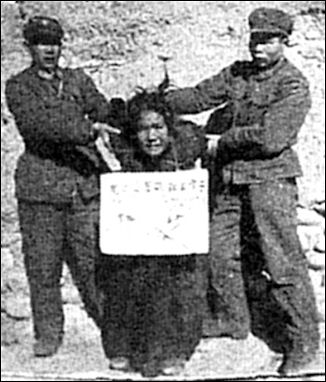
Tibet in 1958 after
the Chinese took it over
Two days after the Dalai Lama escaped from Lhasa, the Communists closed down the Tibetan government, seized land and bombed Potala palace, Sera Monastery and the medical college of Changp Ri. Chinese snipers picked off protestors, some with Molotov cocktails, in the streets. When more 10,000 protestor sought refuge in the Jokhang Temple, it too was bombed. By some estimated 10,000 to 15,000 Tibetans were killed in three days of violence.
After the revolt, the Chinese closed the passes to travel in and out of Tibet, shut down all of Tibet's monasteries, and threw thousands of people into prisons and labor camps. After the suppression campaign began Mao said, "In three months these people will believe in communism."
Chinese View of the 1959 Tibetan Revolt and Afterwards
According to the Chinese government: “In March 1959, the former Tibetan local government and the reactionary clique in the upper strata tore up the 17-article agreement under the pretext of "safeguarding national interests" and "defending religion" and staged an armed rebellion in Lhasa. They instigated rebel forces in different places to attack Communist Party and government offices and kill people, while abducting the Dalai Lama and compelling people to flee the country. [Source: China.org china.org *|*]
“The State Council, acting upon the request of the Tibetan people and patriots in the upper strata, disbanded the Tibet local government (Kasha) and empowered the Preparatory Committee for the Tibet Autonomous Region to exercise the functions and powers of the local government. With the active support of the Tibetan laboring people and patriots of all strata, the People's Liberation Army soon put down the rebellion. *|*
“The Preparatory Committee began carrying out democratic reforms while fighting the rebels. In the farming areas, a campaign was launched against rebellion, unpaid corvee service and slavery and for the reduction of rent and interest. In the pastoral areas, a similar campaign against the three evils was coupled with the implementation of the policy of mutual benefit to herdsmen and herd owners. All the means of production belonging to those serf owners and their agents who participated in the rebellion were confiscated, and the serfs who rented land from them were entitled to keep all their harvests for that particular year. All the debts laboring people owed to them were abolished. The means of production belonging to those serf owners and their agents who did not participate in the rebellion was not confiscated but bought over by the state. Rent for their land was reduced and all old debts owed by serfs were abolished. In the monasteries, the feudal system of exploitation and oppression was abolished and democratic management was instituted." *|*
“Land and other means of production including animals, farm implements and houses confiscated or bought by the state were redistributed fairly and reasonably among the poor serfs, serf owners and their agents, with priority given to the first group. In livestock breeding areas, while the animals owned by manorial lords and herd owners who participated in the rebellion were confiscated and distributed among the herdsmen, no struggle was waged against those who did not participate, their stock was not redistributed, and no class differentiation was made. Instead, the policy of mutual benefit to both herd owners and herdsmen was implemented. Under the leadership of the Communist Party, the million serfs overthrew the cruel system of feudal serfdom and abolished the regulations and contracts that had condemned them to exploitation and oppression for generations. They received land, domestic animals, farm implements and houses and were emancipated politically. In September 1965, the Tibet Autonomous Region was officially established. The Tibetans have since embarked on a road of socialist transformation, cautiously but steadily." *|*
Separatists in Tibet
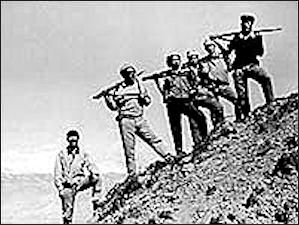
The Khams (Tibetans from the Kham province of Tibet) launched a separatist movement in the mid 1950s after their homeland was annexed by the Chinese and added to Sichuan province and they we ordered to turn in their guns.
Many Khams wore pictures of the Dalai Lama in amulets worn around their necks which they believed would protect them from bullets. For the Khams the Buddhist love of all living things did not extend to the Chinese. One guerilla in the film Shadow Circus: The CIA in Tibet said, “When we kill an animal, we say a prayer, But when we killed Chinese, no prayer came to our lips."
Serious fighting began in January 1956. In one attack, Chinese warplanes bombed a monastery. Thousands of Tibetan reportedly were killed. One fighter told Newsweek, "We didn't know the world. All we did know was that Chinese were killing our people, torturing the monks and destroying our temples. We thought if we are going to die anyway, we might as well die fighting rather than have our throats cut like sheep."
Lacking money and poorly armed and supplied, the Khams approached India and Taiwan for help. New Delhi ignored them and Taipei gave them some weapons. They also met with the Gyalo Thindup, the Dalai Lama's older brother, who put the them in contact with the C.I.A.
C.I.A. in Tibet
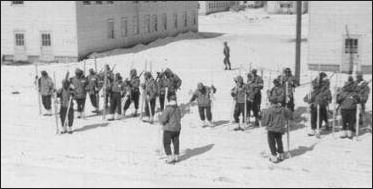
Camp Hale trainingThe C.I.A. agreed to help the Khams by training them in guerilla warfare and helping them run operations in Tibet against the Chinese. The lord chamberlain for the Dalai Lama and other high official were very enthusiastic about the operation. The Dalai Lama himself was skeptical about its aims and its chances of success. The operation, codenamed ST CIRCUS, was by all accounts a disaster. [Source: Melinda Lu, Newsweek, April 19, 1999]
The C.I.A. was taken by the "can-do" spirit and exoticness of the Khams. Their effort began with the training if six Tibetans in Saipan and Okinawa in the 1950s and parachuting them into Tibet to gather intelligence.
After the fighting in Tibet intensified, many Tibetans fled to a refugee camp near Darjeling, India, where the C.I.A., recruited fighters. The first of these recruits were trained by the C.I.A. and parachuted into Tibet from B-17s that took off from an airstrip near Dhaka in present-day Bangladesh. Outfit with communication equipment, they met up with resistance fighters near Lhasa and helped them coordinate their operations.
About 300 Kham recruits were flown to the United States, where they were trained in a camp near Leadville Colorado on how to use automatic weapons and espionage equipment. The Dalai Lama was once introduced to two of the C.I.A."trained guerrillas. He asked them to demonstrate their skills. The warriors pulled out bazookas, fired them and spent 15 minutes reloading them. The Dalai Lama said, "Will you shoot once and then ask the enemy to wait 15 minutes?"
These Tibetan separatists were then infiltrated back into Tibet to fight against the Chinese. Some entered through the Mustang region in Nepal. Others were parachuted out the back of silver C-130s known to the guerrillas as "sky ships."
See Separate Article on the CIA war in Tibet
Film: Shadow Circus: The CIA in Tibet
Later C.I.A. Operation in Tibet

Camp Hale trainingBetween 1957 and 1960, 400 tons of weapons and supplies were dropped from cargo planes to resistance fighters in an operation that cost Washington about $1.7 million a year. Most of the missions were failures. Nine of ten of the guerrillas dropped into Tibet by parachute were killed by the Chinese or committed suicide to avoid capture.
In early 1958, the main Kham resistance group was surrounded by 1,000 artillery-equipped Chinese soldiers. One fighter recalled, "All our leaders were wounded. We kept hoping the C.I.A. would drop us some weapons, but they never came. I went 15 days without food— even shoe leather tasted delicious." The fighters escaped by dispersing and trekking through some of the world's harshest wilderness.
After the U-2 spy plane was shot down over the Soviet Union in 1960, the United States halted missions over Communist airspace. Guerrillas were then launched into Tibet from the Mustang.
In the mid 1960s, when the C.I.A.'s attention was directed towards Vietnam and Indochina, the Leadville facility was showdown. After concluding that the guerrilla's achievements in Tibet were "minimal" and the Tibetans "did not appear to be congenitally inclined towards conspiratorial proficiency" support for the Tibetan guerrillas was reduced and cut off completely after Nixon visited China in 1971. In 1974, Beijing pressured Nepal to shut down the Mustang camps.
In July 1974, a tape-recorded message by the Dalai Lama was delivered to the guerrillas, urging them to lay down their weapons. They agreed. Some were so distraught they decided to commit suicide by drowning themselves or slitting their throats. The last group of guerrillas made their last stand at 18,000-foot-high Tinker Pass, with many dying in a hail of gunfire. Many felt the Tibetan guerrillas were encouraged and then abandoned by the C.I.A. much as anti-Castro Cuban fighters were during the Bay of Pigs. In his autobiography the Dalai Lama wrote the guerilla mission "caused almost more harm to the Tibetans than the Chinese."
Image Sources: Wiki Commons, Save Tibet, Cosmic Harmony, Students for a Free Tibet, Seat 61, 99th infantry battlion,
Text Sources: New York Times, Washington Post, Los Angeles Times, Times of London, National Geographic, The New Yorker, Time, Newsweek, Reuters, AP, Lonely Planet Guides, Compton's Encyclopedia and various books and other publications.
© 2008 Jeffrey Hays
Last updated July 2015


